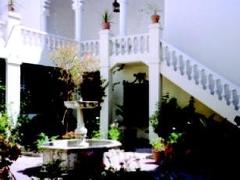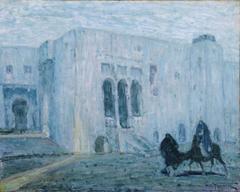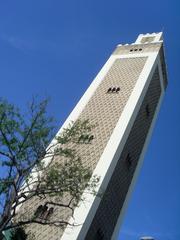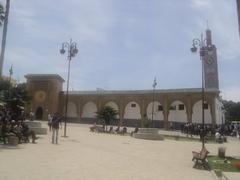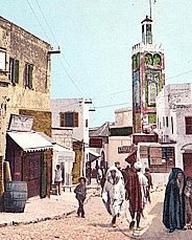Lalla Abla Mosque: Visiting Hours, Tickets, and Comprehensive Travel Guide to Tangier’s Historical Landmark
Date: 04/07/2025
Introduction
Nestled within the dynamic cityscape of Tangier, Morocco, the Lalla Abla Mosque stands as a contemporary beacon of Islamic faith and Moroccan architectural excellence. Officially inaugurated in July 2018 by King Mohammed VI and named for Princess Lalla Abla bint Tahar, the mosque is notable for its modern design, deep spiritual significance, and vital role in Tangier’s urban and cultural landscape. Located at the city’s bustling port—Tangier’s historic gateway between Africa and Europe—the mosque not only serves over 1,900 worshippers but also symbolizes Morocco’s royal heritage and Tangier’s ongoing evolution.
While non-Muslim visitors are generally not permitted within the prayer halls, everyone is welcome to admire the mosque’s stunning exterior, explore the broad esplanade, and engage with Tangier’s vibrant culture. This guide presents essential information on visiting hours, accessibility, etiquette, nearby attractions, and the historical and architectural context of the Lalla Abla Mosque, ensuring a meaningful and respectful visit.
For further insights into Tangier’s religious sites and Moroccan Islamic heritage, see Souk Marocain and Wiztour.
Table of Contents
- Introduction
- Historical Foundations of the Lalla Abla Mosque
- Royal Patronage and Dedication
- Architectural Features and Capacity
- Cultural and Urban Significance
- Integration with Tangier’s Religious Heritage
- Visitor Information: Hours, Tickets, and Guidelines
- Travel Tips and Nearby Attractions
- Frequently Asked Questions (FAQ)
- Conclusion
- References
Historical Foundations of the Lalla Abla Mosque
The Lalla Abla Mosque, established in 2018, honors Princess Lalla Abla bint Tahar, a key figure in the Moroccan royal family and the grandmother of King Mohammed VI. The mosque’s name and royal dedication underscore the monarchy’s role in promoting religious and cultural projects across the country. Situated at the port—the traditional entry point for travelers between Africa and Europe—the mosque is a tribute to Tangier’s cosmopolitan history and its enduring religious traditions.
Royal Patronage and Dedication
King Mohammed VI’s direct involvement in inaugurating the mosque highlights its status as a national and royal symbol. The mosque’s dedication to a royal female figure further emphasizes the monarchy’s commitment to honoring influential figures in Moroccan history and promoting inclusive cultural remembrance. The location at Tangier’s port reflects both a spiritual and diplomatic openness, linking Morocco’s past with its modern ambitions.
Architectural Features and Capacity
Occupying a 5,712-square-meter plot with a 2,720-square-meter esplanade, the mosque can host up to 1,900 worshippers in separate prayer halls for men and women. Its design synthesizes traditional Moroccan motifs—horseshoe arches, intricate zellij tilework, ornate stucco—with modern construction techniques and urban functionality. The complex also includes residential quarters for religious staff and integrated shops, making it both a place of worship and a community hub.
The minaret, visible from the waterfront, is adorned with geometric tile patterns and Quranic inscriptions, and the main entrance is framed by carved cedar wood and decorative metalwork. The mosque’s whitewashed façade and use of local materials help it blend harmoniously with Tangier’s medina and port surroundings.
Cultural and Urban Significance
As Tangier continues its rapid modernization, the Lalla Abla Mosque stands as a vital spiritual anchor and a striking urban landmark. Its proximity to the port means it welcomes locals and visitors alike, serving as a bridge between the city’s ancient medina, its modern business district, and the international port. The mosque’s esplanade is also a lively public space, hosting gatherings during major religious festivals and Friday prayers.
Integration with Tangier’s Religious Heritage
Lalla Abla Mosque complements Tangier’s network of historic religious sites, including the Grand Mosque and the Mohammed V Mosque. Its modern amenities and architectural features embody the city’s blend of tradition and innovation, reinforcing Tangier’s reputation as a crossroads of faith, culture, and history (Souk Marocain).
Visitor Information: Hours, Tickets, and Guidelines
Visiting Hours
- Open to worshippers: From early morning (around 5:00 AM) until evening (around 8:00 PM), aligned with prayer times.
- Non-Muslim visitors: Welcome to admire the exterior and esplanade throughout the day; prayer hall access is restricted to Muslims.
Tickets and Entrance Fee
- Entry: Free; no tickets required for admiring the exterior or visiting the esplanade.
Accessibility
- The esplanade and mosque grounds are mostly flat, making them accessible for most visitors, though some nearby construction may cause uneven surfaces.
Guided Tours and Special Events
- Official guided tours: Rare for the interior, but many local tour operators include the mosque’s exterior as a highlight in city walking tours.
- Special events: During Ramadan and major holidays, the mosque and its square become especially lively.
Photography
- Exterior photography: Allowed; please be respectful and avoid photographing worshippers without explicit permission.
Travel Tips and Nearby Attractions
- Grand Socco: A lively square known for markets and cafes.
- Tangier Medina: Explore labyrinthine streets filled with shops and historic buildings.
- Kasbah Museum: Offers insight into Tangier’s rich cultural history.
- American Legation Museum: A testament to Tangier’s international history.
- Fishing Port: Experience local maritime culture and sample fresh seafood.
Travel Tips:
- Visit during early morning or late afternoon to avoid heat and crowds.
- Dress modestly (covering shoulders, arms, and legs); women are encouraged to wear a scarf as a sign of respect.
- Use comfortable shoes for walking around the medina and port area.
- Always ask for permission before taking people’s photographs.
Frequently Asked Questions (FAQ)
Q: What are the Lalla Abla Mosque visiting hours?
A: The mosque is open for worshippers from early morning until evening. Non-Muslim visitors can view the exterior and esplanade during daylight hours.
Q: Are there tickets or admission fees?
A: No; visiting the mosque’s exterior is free.
Q: Can non-Muslims enter the prayer halls?
A: No, but non-Muslims are welcome to visit the exterior and public areas.
Q: Are guided tours available?
A: Many city tours include the mosque’s exterior; official tours of the interior are rare.
Q: Is the mosque accessible for people with mobility challenges?
A: The esplanade is mostly accessible, though some surfaces may be uneven due to nearby construction.
Q: Is photography allowed?
A: Photography of the exterior is permitted, but please avoid photographing worshippers without their consent.
Q: What is the best time to visit?
A: Early mornings or late afternoons provide the best light and fewer crowds.
Conclusion
The Lalla Abla Mosque is a modern masterpiece firmly rooted in Morocco’s Islamic and royal traditions. Its architectural elegance, strategic location by Tangier’s port, and vibrant role as a community center make it a must-see destination for anyone exploring Tangier’s historical sites. By respecting local customs—modest dress, considerate photography, and observing prayer times—visitors can enjoy a meaningful cultural exchange and gain a deeper understanding of Moroccan spiritual life.
For additional travel inspiration and practical tips, explore Official Tangier Tourism Website and the Audiala app for up-to-date guides and offline maps.
Visuals and Maps
Alt text: Front view of Lalla Abla Mosque at Tangier port
Alt text: Map of Tangier with Lalla Abla Mosque location marked
Internal Links
External Links
- Official Tangier Tourism Website
- Ibn Battuta Travel Guide on Moroccan Mosques
- Life in the Fast Jane Tangier Travel Guide
- Wikipedia: Lalla Abla bint Tahar
Summary Table: Key Visitor Information
| Aspect | Details |
|---|---|
| Location | End of Avenue Mohammed VI, facing Tangier’s new fishing port |
| Access | Exterior view only for non-Muslims; no tickets required |
| Capacity | Over 1,900 worshippers; separate prayer halls for men and women |
| Dress Code | Modest clothing; scarf recommended for women |
| Photography | Permission required; avoid photographing worshippers |
| Facilities | Imam/muezzin housing, shops, large esplanade |
| Safety | Generally safe; avoid unlicensed guides and poorly lit areas |
| Best Time to Visit | Early morning or late afternoon; avoid prayer times and Fridays for crowds |
| Accessibility | Mostly flat esplanade; some uneven surfaces due to nearby construction |
| Local Customs | Polite greetings, accept hospitality, respect prayer times and gender-specific areas |
References
For more information on Tangier’s landmarks and for personalized travel guides, download the Audiala app and follow us on social media for the latest updates.
